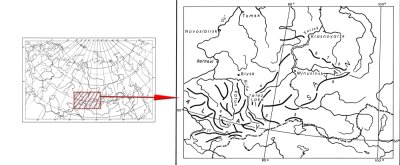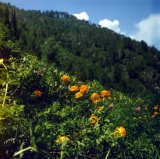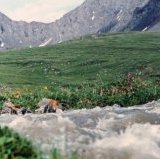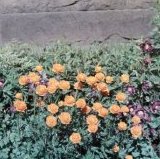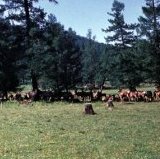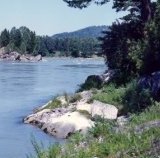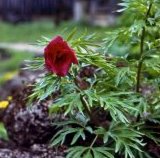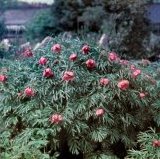 |
QUICK SEARCH
MO PROJECTS:
Africa
Asia/Pacific
Mesoamerica
North America
South America
General Taxonomy
Photo Essays
Training in Latin
America
MO RESEARCH:
Wm. L. Brown Center
Bryology
GIS
Graduate Studies
Research Experiences
for Undergraduates
Imaging Lab
Library
MBG Press
Publications
Climate Change
Catalog Fossil Plants
MO DATABASES:
W³MOST
Image Index
Rare Books
Angiosperm
Phylogeny
Res Botanica
All Databases
INFORMATION:
What's New?
People at MO
Visitor's Guide
Herbarium
Jobs & Fellowships
Symposium
Research Links
Site Map
Search
ORNAMENTAL PLANTS IN THEIR NATURAL HABITATSThe Altay and Sayans A - Altay
A wide range of ornamental plants is found in the Siberian mountains, Altay and Sayan; these regions comprise a special Floristic Province within the Circumboreal Floristic Region (Takhtajan, 1986).
The Altaian flora (including Russia, Kazakstan, Mongolia and China) contains about 2800 species of vascular plants (Kamelin, 1998). Nearly half of the species are Asiatic plants, and 40% of them are Holarctic and Eurasian. Species of a smaller distribution area, occuring in Altay, are mainly common to either the Sayan or Mongolia. About 150 Altaian species of trees, shrubs, and herbs were recommended for cultivation in gardens and parks. In the past few decades, this number has increased to 200 species of herbs and 40 of ornamental shrubs. Of the few Altaian species commonly known, most have been taken into cultivation from areas other than the Altay. For example, a daylily (Hemerocallis minor), which has been widely cultivated in China for many centuries, was introduced into world horticulture from China, but not from the Altay where it is native and represented by a range of interesting forms. The fritillary (Fritillaria meleagris) has been grown in European gardens since the sixteenth century and martagon lily or Turk's cap lily (Lilium martagon) has been cultivated in the Mediterranean since the earliest historical times, but both species were introduced from European populations. However, Altaian populations represent genetic diversity and can enrich the germoplasm of hybrids already in cultivation. Some Altaian species although found in a few garden catalogues are very rarely grown. Among them are a blue large-flowered columbine Aquilegia glandulosa, a lady's slipper red orchid Cypripedium macranthon as well as a large-flowered violet Viola altaica. Those families and genera of the most attractive species of the Altay are only slightly different from those of the Caucasus and Central Asia. The buttercup family, Ranunculaceae, is rich in herbaceous ornamental species for monkshood Aconitum, anemone Anemone, columbine Aquilegia, larkspur, Delphinium, pasque flower Pulsatilla, buttercup Ranunculus and globeflower Trollius. In the daisy (sunflower) family Asteraceae the most conspicuous species belong to chamomile Anthemis, cornflower
One can become acquainted with the Altay's environment by following the old trade and military route (Chuyskiy trakt) from Biysk to Kosh-Agach. Another opportunity to see ornamentals is to take a shorter trip from Gorno-Altaysk, a town in the northern Altay, towards the beautiful Lake Teletz (Teletskoe Ozero) of the Upper Biya. Coniferous forests cover central and northeastern Altay, from the foothills of the Aygulakskiy Ridge and the Katun River up to the Biya River, as well as the land around Lake Teletz. The most common trees here are Siberian pine (Pinus sibirica), Siberian fir Abies sibirica, spruce Picea obovata, Scots pine Pinus sylvestris, Siberian larch Larix sibirica and the common
Although the Altay forests have only a limited number of deciduous trees, they are rather rich in shrub species including pea tree Caragana, honeysuckle Lonicera, rhododendron Rhododendron and spirea Spiraea, all cold-tolerant. For example,
The 77 km (47.8 mi) long Lake Teletz lies in a narrow valley. The Biya River has its source in the lake and later joins the Katun River creating one of the largest Siberian river Ob’. The southern part of Lake Telez is bordered by rugged mountains. Although the cliffs along the lake shore are scenic, they are unsuitable for plant hunting expeditions; however, excursions along the northern shores can be rewarding during the long summers here. Forests of larch Larix and birch Betula grow along the Chuyskiy road that stretches from north to south through Altay. Siberian pine Pinus sibirica is more frequent above 1,000 m (3,280 ft), and together with larch Larix sibirica grows near the altitudinal limit of the Altay montane forest (2,200-2,500 m/7,200-8,200 ft). In the central Altay forests are usually dry associations, rich in shrubs and perennial
The alpine steppes are characterized by particularly noteworthy ornamentals. Some well-known garden subjects can be found growing in the wild. Among them is the alpine aster Aster alpinus, which in this region develops light violet inflorescences larger than elsewhere in its range. The widely appreciated edelweiss is represented by another edelweiss species, Leontopodium conglobatum, L. fedtschenkoanum, L. ochroleuca. Unlike Leontopodium alpinum, which usually grows as solitary plants, these species are caespitose plants and form large impressive tufts. They differ also in their leaves, which are yellowish-grey tomentose. There are different forms, some of them less impressive than L. alpinum, but others very attractive, with larger "edelweiss stars". Fortunately, these species are easy to cultivate. Pink-lilac Goniolimon speciosum, a genus related to limonium; and yellow Patrinia intermedia are also very attractive, with numerous flowers. Many of these ornamental species are quite widespread in the alpine meadows, primarily in central and northern Altay. The subalpine forests are replaced at 1800 to 2000 m (5,900-6,500 ft) by subalpine meadows. Abundant in herbs, these include Aconitum septentrionale, Aquilegia glandulosa, Phleum alpinum, Saussurea pricei, Thalictrum minus and Veratrum lobelianum, and some are also common to alpine meadows. Low shrubs and dwarf trees also dot the low meadow landscape. Among them are Pentaphylloides fruticosa [=Dasiphora fruticosa], Betula rotundifolia and Salix glauca, with dwarf Juniperus shrubs in some places. The grassy alpine meadows are clothed with graminoid Trisetum altaicum, Anthoxanthum odoratum and the sedges Carex atrata and C. tristis. Alpine ornamentals include Anemonastrum crinitum, Aquilegia glandulosa, Callianthemum angustifolium, Dracocephalum grandiflorum, Gentiana decumbens, Geranium albiflorum, Papaver nudicaule and Viola altaica. Along the snowline and water-courses, one can see columbine Aquilegia glandulosa, pansy Viola altaica, primrose Primula nivalis and globeflower Trollius altaicus. This last plant, has orange flowers with a dark purple centre pleasantly contrasting with other Trollius species. A pale lilac globeflower Hegemone lilacina, mentioned among the most interesting plants of the Central Asia, also grows here. Many primroses such as the pink-flowered Primula nutans, the purple-flowered P. longiscapa and the pink-violet P. nivalis, along with the closely related pink-violet cortusa Cortusa altaica, are common. Forget-me-not Eritrichium altaicum and E. villosum should intrigue gardeners because both are attractive cushion plants with blue flowers. The rare and very beautiful Paraquilegia anemonoides grows on rocky slopes in the alpine belt. It has taproots that penetrate deep into stone crevices, leaves that form striking rosettes, and stems, which are twice as long as the leaves, that bear large, pale lilac flowers. Pasque flower, Pulsatilla campanella, which has bluish-violet and narrow, bell-shaped flowers, can be seen in rocky places. The family Crassulaceae is represented by a compact dwarf shrublet Hylotelephium populifolium [=Sedum populifolium], which typically inhabits the rocky slopes above rivers near Lake Telez. Owing to its unusual life form and ease of cultivation, this species is widely appreciated by botanists and gardeners, respectively. Other Crassulaceae desirable for gardens includerodiola Rhodiola rosea, widely distributed, and some local species of the same genus such as R. algida, R. gelida, R. krylovii and R. quadrifida. Siberian tea Bergenia crassifolia, a popular garden plant in the United States, is a plentiful rock inhabitant here. Pseudosedum lievenii, Rosularia alpestris and Sedum albertii are also beautiful plants suitable for the rock garden. The southern part of Altay which is called the Kazak Altay includes the Southern (Yuznyi) Altaian Range. It is home to many resplendent plants, some of them are endemic, e.g., a dwarf Russian almond Amygdalis ledebouriana [=Prunus tenella], Daphne altaica and Pyrethrum kelleri [=Chrysanthemum kelleri]. The last species, Pyrethrum is very rare in nature, but certainly a potentially wonderful garden plant because it has large, 5 cm across inflorescences of white flowers and ornamental leaf rosette. There are other species of the same family Asteraceae in the Altay region that are of horticultural value: Chrysanthemum sinuatum [=Dendranthema sinuatum], Pyrethrum [=Tanacetum] krylovianum, Pyrethrum [=Tanacetum] pulchrum all would be staple bloomers in a garden setting. |
||||||||
| ORNAMENTAL PLANTS FROM RUSSIA |
© 1995-2025 Missouri Botanical Garden, All Rights Reserved
4344 Shaw Blvd.
St. Louis, MO 63110
(314) 577-5100
Technical Support
